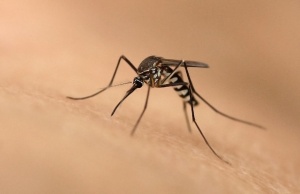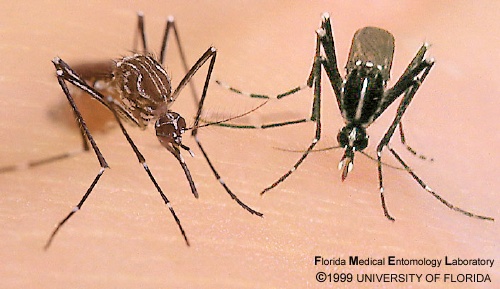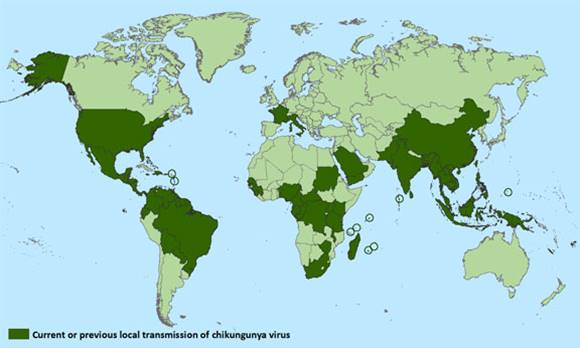Chikungunya Fever: Difference between revisions
No edit summary |
No edit summary |
||
| Line 48: | Line 48: | ||
==== Other Complications<ref name="Obe">Obeyesekere I, Hermon Y. Myocarditis and cardiomyopathy after arbovirus infections (dengue and chikungunya fever). Heart. 1972;34(8):821-827.</ref> ==== | ==== Other Complications<ref name="Obe">Obeyesekere I, Hermon Y. Myocarditis and cardiomyopathy after arbovirus infections (dengue and chikungunya fever). Heart. 1972;34(8):821-827.</ref> ==== | ||
*Cardiac complications were also reported in a number persons infected with the chikunguyna virus resulting in cases of myocarditis and cardiomyopathy. In many cases, these conditions have been noted to resolve spontaneously | *Cardiac complications were also reported in a number persons infected with the chikunguyna virus resulting in cases of myocarditis and cardiomyopathy. In many cases, these conditions have been noted to resolve spontaneously | ||
*Chikungunya fever is rarely fatal however there are cases of death has been reported resulting from severe complications or by a weakened immune system | *Chikungunya fever is rarely fatal however there are cases of death has been reported resulting from severe complications or by a weakened immune system | ||
<br><br><br> | = <br><br>Global Health Issue = | ||
[[Image:CHIKV_map.jpg|center|Map of local Transmission of Chikunguyna virus as of March, 2015. ]] ''' Map of local Transmission of Chikunguyna virus as of March, 2015. ''' <br> | |||
The global expansion of the virus demonstrates the effortlessness with which the virus can spread and infect the human population. | |||
This will in effect can directly reduce productivity and place a burden on the economy on a global level given the long period of illness <br> | |||
== Recent Related Research (from [http://www.ncbi.nlm.nih.gov/pubmed/ Pubmed]) == | == Recent Related Research (from [http://www.ncbi.nlm.nih.gov/pubmed/ Pubmed]) == | ||
Revision as of 21:59, 1 July 2015
Original Editor - Your name will be added here if you created the original content for this page.
Top Contributors - Vanessa Rhule, Lucinda hampton, Rishika Babburu, Evan Thomas, WikiSysop and Kim Jackson
Chikungunya (CHIK-V) Fever
[edit | edit source]
- An acute febrile illness associated with polyarthralgias, caused by the infection of the arthropod-borne alpha-virus, Chikunguyna virus (CHIK-V).
- The virus is transmitted to humans primarily through the bite of an infected mosquito
- The term Chikungunya is derived from the Makinde word meaning “that which bends up” [1]
- The first discovery of the CHIK-V was in 1952 in Tanzania, Africa with the first outbreak noted in 1999 in Malaysia affecting 27 people [2].
- The virus re-emerged in 2004 in countries of the Indian Ocean and has since then, spread to new locations leading to millions of cases throughout countries globally.
Aetiology[edit | edit source]
- The Aedes Aegypti and Aedes Albopictus mosquitos are the main vectors of the virus.
- The human being becomes the reservoir of infection and transmitted from human to human via the infected mosquito.
- These mosquitos bite mainly in the daytime and are also known to transmit the dengue virus [3]
Risk Factors
[edit | edit source]
- There has been increased prevalence in densely populated, urbanized areas, since humans are the only reservoir of the virus.
- Poor living conditions and maintenance of peridomestic environment including pooling of water in water recipients or tyres and inappropriate waste disposal.These are all sources of Aedes mosquito species.[4]
- Migration and Travelling; the CDC estimated approximately 9 million people travel between the United States and the Caribbean each year, increasing the risk of transmission [3]
Clinical Features [1][edit | edit source]
- The incubation period for Chikunguyna fever is noted to be between 3-7 days starting with fevers greater than 38.9°C which can last up to 2 weeks and are biphasic in nature
- Following the fever, majority of infected people develop severe polyarthralgias which are usually symmetric
- Pains are most commonly in the wrists, elbows, fingers, knees and ankles but are not limited to these.
- Pain and Joint swelling are often incapacitating and result in severe disabilities which can last for months.
- The development of a maculopapular rash is often associated
- Additionally, the individual may experience cervical lymphadenopathy, headaches, fatigue, nausea, vomiting, conjunctivitis and myalgia.[5]
- In the acute stage of infection, blood tests may reveal abnormalities such as leukopenia, thrombocytopenia, hypocalcemia and moderate increase in liver function test results
- Asymptomatic cases have also been reported
Musculoskeletal Implications [edit | edit source]
- In the chronic phase of the infection, individuals may experience musculoskeletal symptoms for several weeks to months
- Joint manifestations such as joint effusions, hygromas, bursitis and axial pain can be identified in areas with previously occurring injuries
- Carpal Tunnel syndrome and Raynaud phenomenon in chronic phase have been noted [6]
- Carpal or Cubital Tunnel syndromes are often a result of hypertrophic tenosynovitis of the anterior wrist [6]
Other Complications[7][edit | edit source]
- Cardiac complications were also reported in a number persons infected with the chikunguyna virus resulting in cases of myocarditis and cardiomyopathy. In many cases, these conditions have been noted to resolve spontaneously
- Chikungunya fever is rarely fatal however there are cases of death has been reported resulting from severe complications or by a weakened immune system
Global Health Issue[edit | edit source]
Map of local Transmission of Chikunguyna virus as of March, 2015.
The global expansion of the virus demonstrates the effortlessness with which the virus can spread and infect the human population.
This will in effect can directly reduce productivity and place a burden on the economy on a global level given the long period of illness
Recent Related Research (from Pubmed)[edit | edit source]
Extension:RSS -- Error: Not a valid URL: Feed goes here!!|charset=UTF-8|short|max=10
References[edit | edit source]
References will automatically be added here, see adding references tutorial.
- ↑ 1.0 1.1 Staples J, Breiman R, Powers A. Chikungunya Fever: An Epidemiological Review of a Re‐Emerging Infectious Disease. Clinical Infectious Diseases. 2009;49(6):942-948.
- ↑ Selvaraj I. Chikungunya. Presentation presented at; New Delhi.
- ↑ 3.0 3.1 Cdc.gov. Chikungunya outbreak progresses in Caribbean, Central and South America| CDC Online Newsroom | CDC [Internet]. 2015 [cited 20 June 2015]. Available from: http://www.cdc.gov/media/releases/2014/p1106-chikungunya-outbreak.html
- ↑ Sissoko D, Moendandze A, Malvy D, Giry C, Ezzedine K, Solet J et al. Seroprevalence and Risk Factors of Chikungunya Virus Infection in Mayotte, Indian Ocean, 2005-2006: A Population-Based Survey. PLoS ONE. 2008;3(8):e3066.
- ↑ Rhule V. Chikungunya. Presentation presented at; 2015; Utica, New York and Kingston,Jamaica.
- ↑ 6.0 6.1 Parola P, Simon F, Oliver M. Tenosynovitis and Vascular Disorders Associated with Chikungunya Virus-Related Rheumatism. Clinical Infectious Diseases. 2007;45(6):801-802.
- ↑ Obeyesekere I, Hermon Y. Myocarditis and cardiomyopathy after arbovirus infections (dengue and chikungunya fever). Heart. 1972;34(8):821-827.









